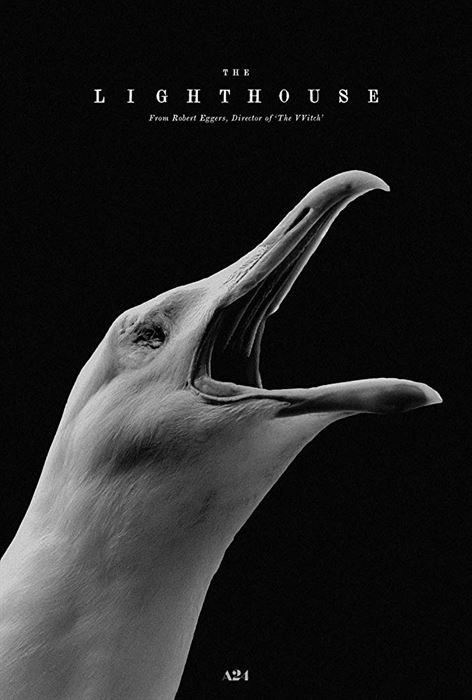Psychological turmoil fuels sophomore director Robert Eggers’ new film “The Lighthouse,” a depraved piece of phallic folklore documenting two lighthouse keepers’ descent into hallucinatory madness.
After his success with “The Witch” in 2015, Eggers has returned to push the boundaries of filmmaking and storytelling. “The Lighthouse” is set in a desolate New England island in 1890, where Ephraim Winslow, played by Robert Pattinson, works under senior wickie Thomas Wake, played by Willem Dafoe.

Willem Dafoe gives an Oscar worthy performance as Thomas Wake in “The Lighthouse.” Photo courtesy of A24
Through a withered face and whiskers, Thomas commands Ephraim. He curses to a wretched sea and demands respect between gulps of kerosene, tormenting and abusing Ephraim physically and emotionally.
Vixenish mermaids and tentacles are only a small part of the sailors nightmares as they fall deeper and deeper into isolated madness. Drawing upon German expressionism, Grecian myth and more, Eggers creates a unique sense of history in a cautionary tale that explores themes of masculinity and isolation. Grueling performances, harrowing visuals and thoughtful sound design create a nautical nightmare that revitalizes the silent film for modern cinema.
The distinct visual quality and sound design gives “The Lighthouse” an indulgence that swallows viewers into the setting. In the theater, I could feel the salty fog settling on my skin and smell the fishy storm waves. It is an intimate experience that demands the viewer’s presence.
Part of the film’s allure is cinematographer Jarin Blaschke’s decision for a distinct visual style – a nearly perfect square frame and black and white image. The archaic 1.19:1 aspect ratio calls back to the silent film era of old Hollywood. It establishes the film as a relic from the past, a piece of folklore passed down through generations. The small frame is suffocating, intimate and invasive. The characters are constantly pushed together inside the walls of the frame, intensifying their building resentment.

Cinematographer Jarin Blaschke uses vintage lenses and 35mm film to create a period appropriate look. Photo courtesy of A24
The black and white film stock makes the contrast between sane and insane that much more defined, while reality falls into the expanse of gray sky in between. Blaschke’s decision to shoot on 35mm film gives the image a texture as gritty and unclean as the events unfolding on screen.
Beyond the visuals, the tense atmosphere is built by a fully immersive sound design. The mocking laughter of the seagulls and the penetrating yell of the foghorn cut through a dewy silence. Thomas’ urinating, grunting and farting echo through the cabin like a gong. The sound is hypnotic, each beat striking like a ticking clock until you are as numb to the piercing maritime environment as the characters.
The sense of impending doom is further built by Mark Korven’s score. Korven guides the film, weaving his mechanical drone with the ambiance seamlessly. The sound builds to a harrowing climax, underscoring one of the most intense and satisfying ending sequences I’ve seen to date.
Though the visual and auditory sensations are what tonally and atmospherically create the film, the story is brought to life by the powerhouse performances of Pattinson and Dafoe. The actors approach the characters with no reservation, bringing forward an untamed, primitive human madness.
Pattinson’s slow descent into psychosis is mesmerizing, deeply thoughtful and impressively reflected in his character choices. He portrays emotional turbulence with an unconstrained physicality.
While Pattinson delivers, Dafoe carries the film with what may be his best performance to date. He commands the Eggers brothers’ dialogue with finesse, finding a poetic cadence in long monologues of colloquial sailor jargon. He walks the line with a limp leg between an intimidating ruthless commander and comically unhinged old man – a balance that breathes life and verisimilitude into the character.
Though Dafoe and Pattinson both succeed independently, the most impressive aspect of the performance is how well they work together. Constantly dancing between screaming matches and jigs, fighting and sexual tension, kinship and vengeance, Dafoe and Pattinson take cabin fever to a new level.

Robert Eggers’ “The Lighthouse” is a follow-up to his successful directorial debut, “The Witch.” Photo courtesy of A24
“The Lighthouse” is a beautifully crafted painting of madness and forbidden desire that is in equal parts entertaining and disturbing. It is an alluring visual masterpiece that successfully translates the feeling of insanity through the sounds of seagulls and sea shanties.
The successful and unique vision makes it an instant classic and one of the best films to be released this year, despite being a far cry from the conventional horror film. With “The Lighthouse,” Eggers has laid the foundations for a new genre of art house film that defies traditional genre expectations of horror and comedy. It is an exciting achievement and mark of skill for Eggers, an auteur who could very well go into film history as one of the best directors of the 21st century.



